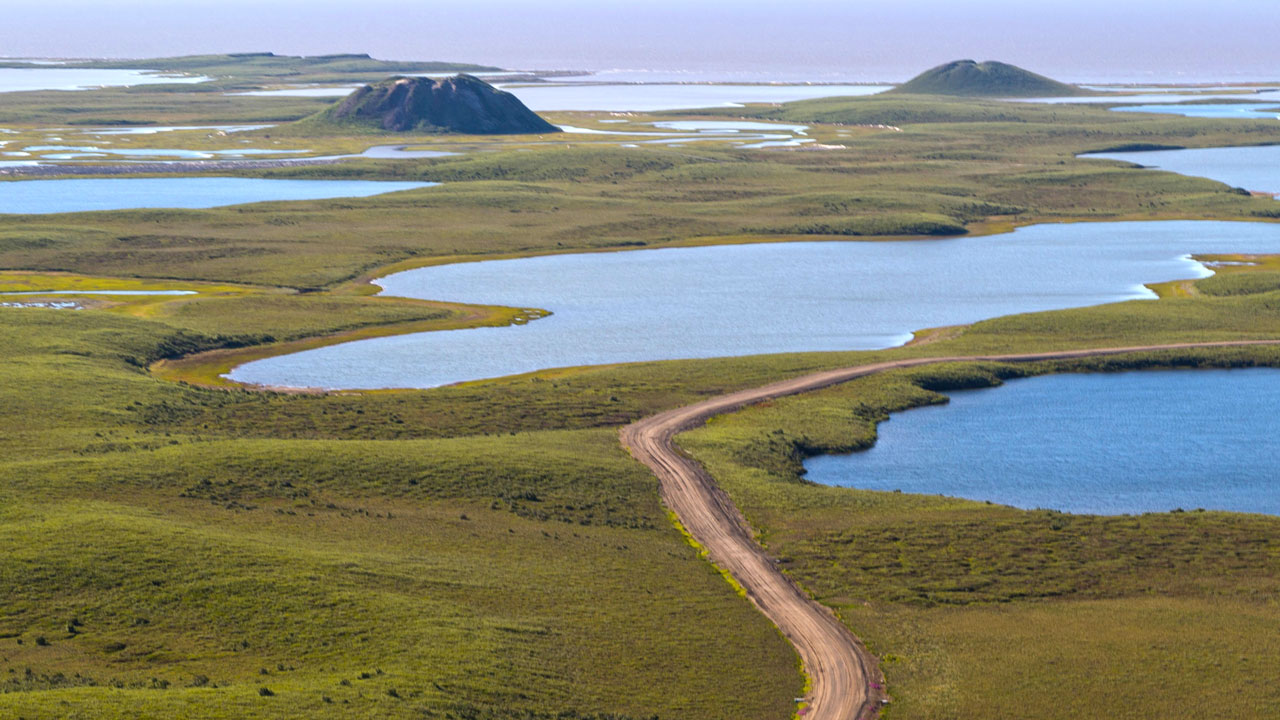
What is the main challenge in transportation development in the northern and Arctic regions?
Constructing roads, highways, or runways in the northern and Arctic regions presents many challenges. These regions are remote, and while the summers are beautiful, construction often needs to occur in the winter when it is cold and dark. The costs are high, and access to equipment and materials can be challenging. Access to sites may be limited to seasonal winter snow and ice roads, and although winter can feel long, this access is not reliable due to climate warming.
Even upon completion, the infrastructure remains vulnerable to the perils of climate change, a risk shared with road, highway, or runway development in southern Canada, with one crucial difference—permafrost. Permafrost, that permanently frozen layer of soil, gravel and sand, bound together by ice below the earth’s surface, can be the strength and resilience of transportation infrastructure if it stays frozen, or can result in degradation and destruction if it thaws.
How is this challenge overcome?
In some areas permafrost is not continuous, so with careful planning, it can be avoided. Where permafrost is continuous, or cannot be avoided, the key is to design and construct the infrastructure in a manner that preserves the frozen state of the permafrost. This is done by knowing the permafrost and geotechnical conditions in the area where you are working, considering the proposed drainage regime required for the infrastructure, understanding the potential changes to the climate and integrating these aspects early in the planning and design stages of the project. Such considerations form the foundation for developing adaptive solutions that minimize permafrost disturbance and enhance climate resilience. Some of these solutions include fill-only construction techniques, agrading (raising) permafrost into the embankment, using adfreeze piles founded in permafrost for bridge abutments and piers, and employing passive ground cooling technologies and winter construction methods.
How is Tetra Tech assisting clients in the development of transportation infrastructure in permafrost?
For each project Tetra Tech assembles multidisciplinary teams of engineers, scientists, and technicians with relevant transportation development experience in northern regions. While the geotechnical engineer on the team will be the lead permafrost expert, each other team member will have a high level of experience in working in northern permafrost regions. Everyone from the project manager to the environmental scientist, transportation engineer, civil technologist, water resources engineer, climate specialist, construction manager and others and will understand how their role on the project contributes to resilient designs that preserve permafrost for the life of the project.
The teams work collaboratively from the project’s initial conceptual and planning stages through the environmental review, field investigation, design, and construction stages to completion. Avoidance or preservation of permafrost will be among the top priorities from the start, with each individual team member contributing knowledge from their respective discipline and experience. The geotechnical engineer will provide initial information to identify ice-rich and thaw-sensitive areas that the transportation engineer will consider when routing or siting the infrastructure. Climate specialists will provide projections of climate warming that are considered in the early stages of the project and utilized more thoroughly in the modelling and design stages to adapt embankment, alignments and bridge foundations. Cost considerations are also incorporated from the project’s early stages to ensure that the infrastructure is affordable to build and operate.
Tetra Tech offers comprehensive lifecycle services for northern transportation, supported by our offices in Yellowknife and Whitehorse. We work closely with local Indigenous Peoples through business partnerships with Indigenous organizations, beneficiaries, and participants under land claim agreements. Our Indigenous business partnerships include Kiggiak-EBA Consulting Ltd. in the Inuvialuit Settlement Region, Northwest Territories; Nehtruh-EBA Consulting Ltd. in the Gwich’in Settlement Area, Northwest Territories; and NELPCo with Na-Cho Nyäk Dun Development Corporation in Yukon.
About the authors
Matt Keleher
Matt Keleher is a Professional Engineer registered in the Northwest Territories, Nunavut, Yukon, and British Columbia, Canada.
He has more than 10 years’ widespread experience in highways and municipal transportation projects in northern Canada and the Arctic, Australia, and the United Kingdom. He has worked closely with clients ranging from the federal government departments to local communities and Hamlets clients on a wide array of transportation projects in northern Canada. Matt is adept at coordinating and being an integral member of diverse, multidisciplinary teams required when developing innovative engineering solutions in the challenging conditions, such as for northern infrastructure projects in Canada.
Ed Grozic
Ed Grozic is a Professional Engineer registered in Northwest Territories, Nunavut, Yukon, and Alberta.
He has more than 29 years of work experience on northern transportation, infrastructure, energy, mining, and environmental cleanup projects. He holds a Bachelor Science in Civil Engineering and a Master of Engineering in Geotechnical Engineering from the University of Alberta. He is a Principal Consultant and Director of Strategic Projects for the Arctic Region and is the General Manager of two of Tetra Tech’s Indigenous partner companies: Nehtruh-EBA Consulting Ltd. in the Gwich’in Settlement Area and Kiggiak-EBA Consulting Ltd. in the Inuvialuit Settlement Region in the Northwest Territories. Ed is a contributing author to a number of publications including the Transportation Association of Canada (TAC) Guidelines for Development and Management of Transportation Infrastructure in Permafrost Regions.